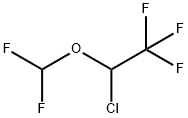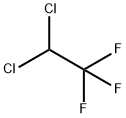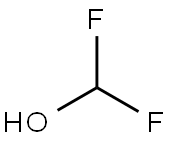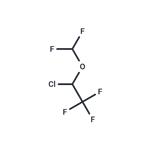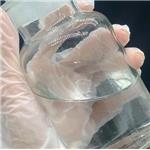Chemical Properties
colourless liquid
Originator
Forane,Ohio Medical,US,1980
Uses
Solvent and dispersant for fluorinated materials.
Uses
Isoflurane is a volatile anesthetic agent mainly used to study its interaction with the biological system.
Uses
Isoflurane is a halogenated ether used for inhalational anesthesia. Recent studies suggest that there might be a relationship between administration of isoflurane and postoperative cognitive dysfunct
ion (POCD).
Definition
ChEBI: Isoflurane is an organofluorine compound. It has a role as an inhalation anaesthetic. It is functionally related to a methoxyethane.
Manufacturing Process
A 1-liter 3-necked stainless steel flask was fitted with a copper "Dry Ice" cold
finger condenser, a stainless steel stirring shaft and gland and a copper gas
inlet tube. To the flask there was then added 50 g (0.23 mol) of
CF3CHClOCHCl2 and 1.5 g of SbCl5 · HF gas was then slowly bubbled through
the stirred mixture which was maintained at 0°C. The reaction was run until
0.35 mol of HCl was collected, as indicated by the titration of the effluent gas
which was dissolved in water. Following the fluorination 26 g of material were
recovered and determined to be 90% pure by vapor phase chromatography.
Fractional distillation using a 30 x 0.5 cm column packed with glass helices
gave the pure product, BP 48°C to 48.5°C.
brand name
Forane (Baxter Healthcare).
Therapeutic Function
Inhalation anesthetic
Biological Functions
Isoflurane (Forane) is a structural isomer of enflurane
and produces similar pharmacological properties: some
analgesia, some neuromuscular blockade, and depressed
respiration. In contrast, however, isoflurane is considered
a particularly safe anesthetic in patients with ischemic
heart disease, since cardiac output is maintained,
the coronary arteries are dilated, and the myocardium
does not appear to be sensitized to the effects of catecholamines.
Also, blood pressure falls as a result of vasodilation,
which preserves tissue blood flow. Isoflurane
causes transient and mild tachycardia by direct sympathetic
stimulation; this is particularly important in the
management of patients with myocardial ischemia.
Unlike enflurane, isoflurane does not produce a
seizurelike EEG pattern. Furthermore, the metabolic
transformation of isoflurane is only one-tenth that of
enflurane, so fluoride production is quite low. Among
the halogenated hydrocarbons, isoflurane is one of the
most popular, since it preserves cardiovascular stability
and causes a low incidence of untoward effects.
General Description
Isoflurane is a volatile liquid (bp=48.5°C) with an MAC of1.15, a blood:gas partition coefficient of 1.43 and high solubilityin fat. Isoflurane is a structural isomer of enflurane. Itis a known respiratory irritant, but less so than desflurane.Approximately 0.2% of the administered drug undergoesmetabolism, the rest is exhaled unchanged. The metabolismof isoflurane yields low levels of the nephrotoxic fluoride ionas well as a potentially hepatotoxic trifluoroacetylating compound). The relatively low concentrations ofthese compounds have resulted in very low risks of hepatotoxicityand nephrotoxicity. There have been no reports ofseizures caused by isoflurane and only transient increases inheart rate have been reported.
Biochem/physiol Actions
Isoflurane is a tandem pore potassium channel activator. It is also a very widely used anesthetic for animal research and for in vitro studies on anesthesia mechanisms.
Clinical Use
Isoflurane was introduced in the United States in 1981 and is a potent anesthetic agent
with many similarities to its isomer enflurane (potent, nonflammable, and intermediate blood
solubility). It does produce significantly fewer cardiovascular effects than enflurane, however, and
it can be used safely with epinephrine without as great a concern for arrhythmia production.
Isoflurane has a more pungent odor than halothane and, thus, can cause irritation to the throat and
respiratory tract, triggering coughing and laryngospasm. To overcome this problem, it often is
supplemented with intravenous agents. Less than 0.2% of an administered dose is metabolized,
mostly to fluoride and trifluoroacetic acid. Some minimal potential
for hepatotoxicity is associated with a trifluoroacetyl halide metabolite.
Synthesis
Isoflurane is prepared by chlorination
of 2,2,2-trifluoroethoxydifluoromethane, itself
obtained by alkylation of trifluoroethanol with
difluorochloromethane , :

Veterinary Drugs and Treatments
Isoflurane is an inhalant anesthetic that has some distinct advantages
over either halothane or methoxyflurane due to its lessened
myocardial depressant and catecholamine sensitizing effects, and
the ability to use it safely in patients with either hepatic or renal
disease. Isoflurane’s higher cost than either methoxyflurane or halothane
is a disadvantage.
Horses may recover more rapidly than with halothane, but be
more susceptible to anesthetic associated-
myopathy.
